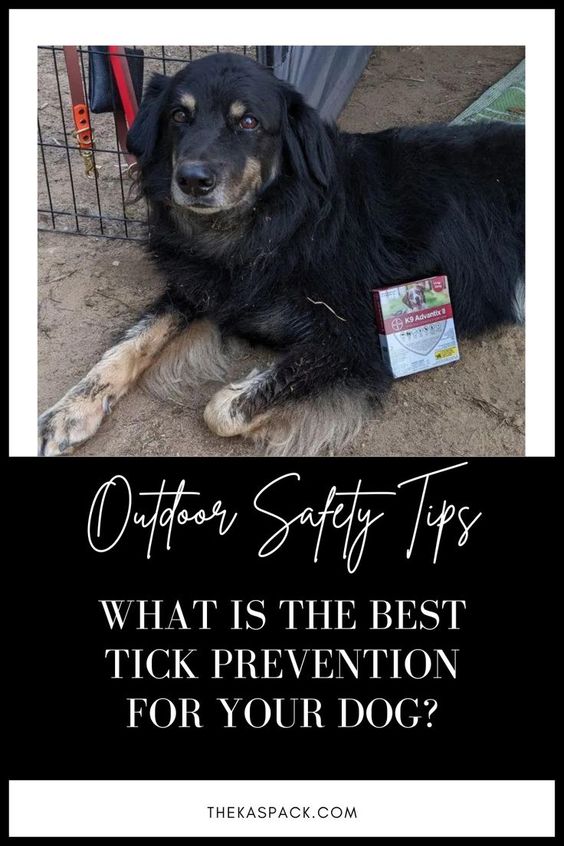What is the Safest Tick Preventative for Dogs?
Choosing the best tick preventative for dogs will depend on a variety of different factors. This includes your dog’s medical history, whether you are more focused on finding a tick repellent or tick preventative for dogs, and your level of risk.
If you’re feeling overwhelmed by the options, this article is for you. We’re going to take a deep dive into the reasons why tick repellent and preventative for dogs are important, the risks that ticks pose for your dog, and how to choose the best solution for you and your dog.
We’ll also discuss what to do if you find a tick on your dog including safely removing a tick as well as why you should consider having the tick tested to better understand your risk of tick-borne diseases.

This post contains affiliate links, which means if you click and buy, we will make a commission (at no cost to you). See my full disclosure policy for more details.
Do Dogs Really Need Tick Medication?
It’s one of the biggest questions that we get when discussing the risks of ticks and dogs – Do you really need to invest in a tick solution for dogs? The truth is despite their small size, ticks can prevent a very serious and life-altering threat to your dogs.
In a 2019 report, the Canadian government listed 5 tick-borne diseases that are prevalent in the country. This includes:
- Lyme disease
- Anaplasmosis
- Babesiosis
- Powassan virus
- Borrelia miyamotoi disease
The list provided by the Centers for Disease Control and Prevention in the US is even longer. They list a total of 16 different tick-borne diseases that exist in the US. Of course, these aren’t all heavily present in every area of the country, but it is safe to say that there is the potential of at least one wherever you may be exploring.
There are many steps you can take to help reduce your risk of picking up an unwanted hitchhiker while outdoors. But the most effective way to prevent ticks on dogs is with the use of a tick-specific product like a preventative or repellent. Many of these products will also offer protection from other outdoor pests including fleas and even mosquitoes.
While you can raise a happy, healthy dog without the use of tick preventatives, we strongly believe that it’s not worth the risk to spend time outdoors without taking adequate precautions.
What is the Best Method of Tick Prevention for Dogs?
There is no single best tick preventative for dogs. Instead, you will need to determine which of the options available are best for you and your dog based on several factors.
One major consideration is whether you would be better off with a topical tick repellent for dogs or an oral option. Oral preventatives work by killing the tick when it bites. But this means the tick must first bite your dog which still leaves a window of opportunity for transmitting diseases. A topical tick repellent works like a bug spray, discouraging them from getting onto your dog in the first place.
Dog owners that spend more time outdoors in high tick areas may want to focus on selecting a stronger tick preventative or repellent. If you are unsure of the risk of ticks in your area, contact your local health unit. But keep in mind, even in low-risk areas, your dog may encounter ticks while taking a walk, visiting the park, or even spending time in the backyard.
You may also need to consider your dog’s personal preferences. For example, many dogs are okay with the use of topical tick treatments, but that doesn’t mean it won’t make your dog feel anxious or uncomfortable. On the other hand, some dogs refuse to take pills or oral medications.
Pay attention to your dog’s body language when introducing a new tick preventative. This can help you to gauge whether your dog is comfortable with the current option and pivot, if necessary.
In our home, we use K9 Advantix II Flea and Tick Prevention. It’s a topical treatment that we use on our dogs once a month. In addition to protecting them against fleas and ticks, it’s also effective at repelling mosquitoes, lice, and biting flies. If a tick does get onto your dog, the treatment quickly takes care of them, preventing them from biting.
Note: K9 Advantix II Flea and Tick Prevention IS toxic to cats! If you live in a home with cats like we do, you can still use the option. But you need to keep your dog and cat separated when administering the medication and carefully wash anything that has been in contact. Dispose of the packaging and any gloves you wore while administering it immediately to prevent your cat from having access.

What Months Should You Give Your Dog Flea and Tick Medicine?
One of the biggest misconceptions when it comes to preventing ticks on dogs is that these steps are only necessary during the warmer spring and summer months. But the truth is that there is a degree of risk all year long – even during December through February when parasites like fleas and ticks are at their least active.
All it takes is a single mild day in the colder months and your dog can be exposed. Why risk it?
What is the Best Natural Tick Preventative for Dogs?
Another question that we hear a lot relating to ticks and fleas is whether there is a reliable homemade tick repellent for dogs.
I will not deny that there are some options that people swear by. But I highly recommend turning to a natural tick preventative that is still made under the care and guidance of professionals. There are many great companies creating natural solutions that they can guarantee will be safe for your dog to use.
One product line that we recently discovered while attending SuperZoo 2022 was the Nature’s Protection Flea & Tick Prevention line by Earth Animal. These products were developed to repel and protect against fleas and ticks using herbs, essential oils, vitamins, and minerals. They even have a natural bug spray that’s suitable for use by dogs, kids, and adults.
Full disclosure: We have not tried this product ourselves. The information provided is the information readily available by the company and from reviews of those who have used it.
If you are considering using a natural preventative, we recommend still discussing it with your veterinarian. They will be able to help you find the best natural option for your dog while also educating you on any potential risks or concerns involved with the use of the specific products that you are contemplating.
In addition to using a tick preventative or repellent, there are a few habits you should get into to help avoid a tick bite or spot a tick early.
When heading out on a hike with your dog, you should always stay on the trail. Not only is this important for environmental preservation in the area, but it also reduces your risk of ticks. These little hitchhikers often hang out in long grass and brush. By not walking through these unkept areas, you limit their access to you and your dog.
After your outdoor adventure, carry out a meticulous tick check. This means checking over your dog from nose to tail including the most common areas for a tick to hide out – in and around the ears, around the eyes, around the neck (under the collar), in the armpits, between the toes, in the groin area, or around the tail. If you spot a tick that hasn’t yet latched onto your dog, it can easily be removed. One hack that has been going around and works beautifully is to run a lint roller over the area and the ticks will become stuck to it. But if you find an engorged tick on a dog or a tick that has just latched on, you will need to be much more careful with the removal.
How to Remove a Tick from Your Dog
The above preventatives are a great way to prevent a tick infestation on your dog, but you may still encounter a tick at some point in your outdoor adventures. None of the options listed are 100% foolproof. If you do find a tick, stay calm – the goal is to remove it safely from your dog as quickly as possible. The longer the tick is present, the greater the risk of tick-borne diseases.
To safely remove a tick, you will need a pair of tweezers, or a special tool designed to effectively remove ticks. We recommend the use of the tool. When removing a tick using tweezers, you run the risk of squeezing the tick too hard which can cause the tick to release saliva into the dog’s bloodstream including any potential tick-borne diseases that they are carrying.
We have recently added an interesting tick removal tool to our outdoor gear. It’s a Tick Remover Card which is the size of a basic credit card and easily slides into a hiking backpack or pocket.
If you are using a tool, slide the tool along the skin on the side of the tick until it is securely between the two prongs or sides of the designated removal spot. Gently lift and turn the tool until you feel that the tick releases its hold on your dog and immediately place the tick in a plastic bag or container where it will be safely contained.
For those that prefer the use of tweezers, carefully take hold of the tick as close to the skin’s surface as possible without grabbing onto the head. With steady (but not too hard) pressure on the tick, pull straight away from the surface of your dog’s skin without any twisting movements. Twisting with tweezers can separate the mouthparts of the tick from the body, leaving it under the skin which can lead to infection or other complications.

Why You Should Test Ticks for Potential Tick-Borne Diseases
Tick testing is a process in which a lab tests the tick to identify any diseases that it may be carrying. This doesn’t necessarily mean that the disease has been transmitted to you or your dog, but it does mean that there is a chance. On a positive note, it can also help you to rule out a problem. If the tick responsible for biting you or your dog doesn’t carry a disease, it can’t transmit it.
Some locations in Canada and the United States offer tick testing through the local public health units. This is most common in high-risk areas where the government is attempting to track the presence of these diseases and the risks they pose to the community.
If you don’t live in an area that offers this service, there is a company called TickCheck that can do the testing for you. This is a great way to be proactive with your dog’s care. Diseases like Lyme respond best to treatment when they are addressed as soon as possible. Unfortunately, they often aren’t identified until they have had the chance to progress to a more serious level.
To do this, complete a tick testing order form on the company’s website and you will receive a receipt and mailing label. Using this, place the tick in a small plastic bag into an envelope and send the tick to the lab. At the time of writing this, the turn-around time for results is 72 hours from receipt of the tick to the testing facility.

What steps do you take to prevent ticks when hiking or camping with your dogs? Let us know your go-to approach in the comments section!
